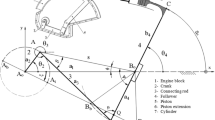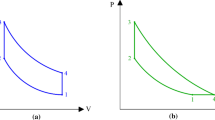Abstract
As an alternative power source for hybrid electrical vehicle(HEV), electric generating system(EGS) driven by sphere cam engine(SCE) is said to own higher power density and integration. In this work, the structure and working principle of EGS were introduced, based on which the advantages of EGS were displayed. The profile of sphere cam was achieved after the desired motion of piston was given. After establishing the dynamic model of power transmission mechanism, the characteristics of cam-roller mechanism were studied. The results show that the optimal cam profile of SCE is a sinusoid curve which has two peaks and two valleys and a mean pressure angle of 47.19°. Because of the special cam shape, the trace of end surface center of piston is an eight-shape curve on a specific sphere surface. SCE running at speed of 3000 r/min can generate the power of 33.81 kW, which could satisfy the need of HEVs. However, the force between cylinder and piston skirt caused by Coriolis acceleration can reach up to 1182 N, which leads to serious wear between cylinder liner and piston skirt and may shorten the lifespan of SCE.
Similar content being viewed by others
References
AXSEN J, KURANI K S. Hybrid, plug-in hybrid, or electric-what do car buyers want? [J]. Energy Policy 2013, 61: 532–543.
RUI Xian-hong, YAN Qing-yu, MARIA S K, LIM T M. Li3V2(PO4)3 cathode materials for lithium-ion batteries: A review [J]. Journal of Power Sources 2014, 258: 19–38.
VERHELST S, SHEPPARD C G W. Multi-zone thermodynamic modelling of spark-ignition engine combustion—An overview [J]. Energy Conversion and Management 2009, 50(5): 1326–1335.
HANNAN M A, AZIDIN F A, MOHAMED A. Hybrid electric vehicles and their challenges: A review [J]. Renewable and Sustainable Energy Reviews 2014, 29: 135–150.
GUPTE S. Experimental analysis and feasibility study of 1400CC diesel engine car converted into hybrid electric vehicle by using BLDC hub motors [C]// 4 International Conference on Advances in Energy Research (Icaer 2013). Mumbai, India: Indian Inst Technology Bombay Department-Energy Sci & Engn 2014, 54: 177–184.
KIM J, JEONG Y H, JEON Y H, KANG J H, LEE S, PARK J Y. Development of a switched reluctance motor-based electric AC compressor drive for HEV/EV applications [J]. Journal of Magnetics 2014, 19(3): 282–290.
NIETO N, DIAZ L, JOHN G, BLANCO F, RAMOS J C, RIVAS A. Novel thermal management system design methodology for power lithium-ion battery [J]. Journal of Power Sources 2014, 272: 291–302.
VERHELST S, SIERENS R. A quasi-dimensional model for the power cycle of a hydrogen-fuelled ICE [J]. International Journal of Hydrogen Energy 2007, 32(15): 3545–3554.
RIBAU J P, SILVA C M, SOUSA J M C. Efficiency, cost and life cycle CO2 optimization of fuel cell hybrid and plug-in hybrid urban buses [J]. Applied Energy 2014, 129: 320–335.
SEAMAN A, DAO T S, MCPHEE J. A survey of mathematics-based equivalent-circuit and electrochemical battery models for hybrid and electric vehicle simulation [J]. Journal of Power Sources 2014, 256: 410–423.
SUN Hong-guang, DIXON R. Development of cooling strategy for an air cooled lithium-ion battery pack [J]. Journal of Power Sources 2014, 272: 404–414.
CHOI Y S, KANG D M. Prediction of thermal behaviors of an air-cooled lithium-ion battery system for hybrid electric vehicles [J]. Journal of Power Sources 2014, 270: 273–280.
RICHARD V B, FRED S. Internal combustion engine handbook basics, components, systems, and perspectives [M]. Warrendale: SAE International, 2004: 437–454.
NOAH D, MANRING, MEHTA V S, BRYAN E, NELSON J G, KEVIN J G, JEFF L. KUEHN. Scaling the speed limitations for axial-piston swash-plate type hydrostatic machines [J]. Journal of Dynamic Systems, Measurement, and Control 2014, 136(3): 031004.
ZHANG Lei, XU Hai-jun, PAN Cun-yun, XU Xiao-jun. Combustion simulation and key parameter optimization for opposite axial piston engine in small scale [J]. Journal of Central South University 2015, 22(9): 3397–3408.
DENG Hao, PAN Cun-yun, WANG Xiao-Cong, ZHANG Lei, DENG li. Comparison of two types of twin-totor piston engine mechanisms [J]. Journal of Central South University 2013, 20(2): 363–371.
SHI Chun-tao, QIN De, TANG Qi, TIAN Xiao-song. Developments in combustion modeling in ICE [J]. Agriculture mechanical engineering 2013, 38(4): 181–185. (in Chinese)
OPPENHELM A K. Dynamics of combustion systems [M]. Heidelberg: Springer-Verlag, 2007: 3–61.
Author information
Authors and Affiliations
Corresponding author
Additional information
Foundation item: Projects(51475464, 51175500, 51575519) supported by the National Natural Science Foundation of China
Rights and permissions
About this article
Cite this article
Zhang, L., Pan, Cy., Xu, Xj. et al. An investigation of cam-roller mechanism applied in sphere cam engine. J. Cent. South Univ. 23, 825–833 (2016). https://doi.org/10.1007/s11771-016-3129-6
Received:
Accepted:
Published:
Issue Date:
DOI: https://doi.org/10.1007/s11771-016-3129-6




